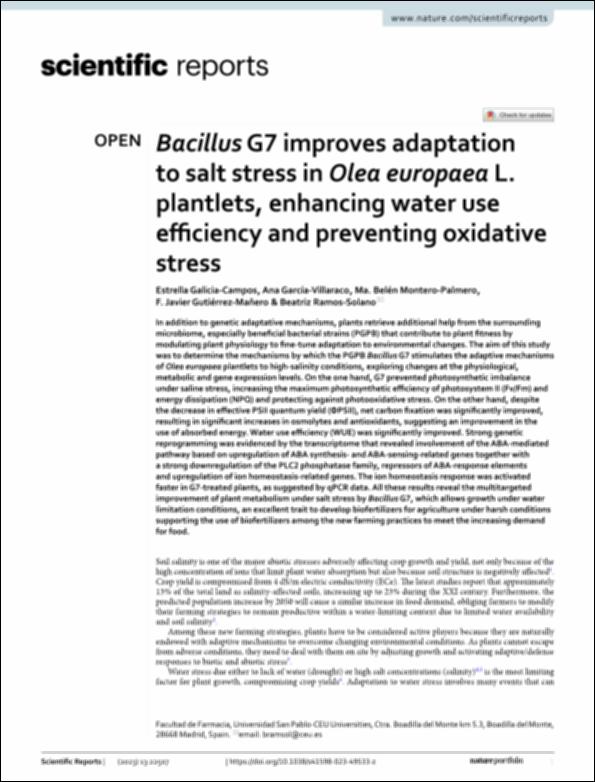Por favor, use este identificador para citar o enlazar este ítem:
http://hdl.handle.net/10637/14723Bacillus G7 improves adaptation to salt stress in Olea europaea L. plantlets, enhancing water use efficiency and preventing oxidative stress
| Título : | Bacillus G7 improves adaptation to salt stress in Olea europaea L. plantlets, enhancing water use efficiency and preventing oxidative stress |
| Autor : | Galicia Campos, Estrella García Villaraco, Ana Montero Palmero, María Belén Gutiérrez Mañero, Francisco Javier Ramos Solano, Beatriz |
| Materias: | Biotechnology; Microbiology; Plant sciences |
| Editorial : | Nature Research |
| Citación : | Galicia-Campos, E., García-Villaraco, A., Montero-Palmero, M.B. et al. Bacillus G7 improves adaptation to salt stress in Olea europaea L. plantlets, enhancing water use efficiency and preventing oxidative stress. Sci Rep 13, 22507 (2023). https://doi.org/10.1038/s41598-023-49533-z |
| Resumen : | In addition to genetic adaptative mechanisms, plants retrieve additional help from the surrounding microbiome, especially beneficial bacterial strains (PGPB) that contribute to plant fitness by modulating plant physiology to fine-tune adaptation to environmental changes. The aim of this study was to determine the mechanisms by which the PGPB Bacillus G7 stimulates the adaptive mechanisms of Olea europaea plantlets to high-salinity conditions, exploring changes at the physiological, metabolic and gene expression levels. On the one hand, G7 prevented photosynthetic imbalance under saline stress, increasing the maximum photosynthetic efficiency of photosystem II (Fv/Fm) and energy dissipation (NPQ) and protecting against photooxidative stress. On the other hand, despite the decrease in effective PSII quantum yield (ΦPSII), net carbon fixation was significantly improved, resulting in significant increases in osmolytes and antioxidants, suggesting an improvement in the use of absorbed energy. Water use efficiency (WUE) was significantly improved. Strong genetic reprogramming was evidenced by the transcriptome that revealed involvement of the ABA-mediated pathway based on upregulation of ABA synthesis- and ABA-sensing-related genes together with a strong downregulation of the PLC2 phosphatase family, repressors of ABA-response elements and upregulation of ion homeostasis-related genes. The ion homeostasis response was activated faster in G7-treated plants, as suggested by qPCR data. All these results reveal the multitargeted improvement of plant metabolism under salt stress by Bacillus G7, which allows growth under water limitation conditions, an excellent trait to develop biofertilizers for agriculture under harsh conditions supporting the use of biofertilizers among the new farming practices to meet the increasing demand for food. |
| Descripción : | Este artículo se encuentra disponible en el siguiente enlace: https://rdcu.be/dtSeI |
| URI : | http://hdl.handle.net/10637/14723 |
| Derechos: | http://creativecommons.org/licenses/by-nc-nd/4.0/deed.es OpenAccess |
| ISSN : | 2045-2322 |
| Fecha de publicación : | 15-dic-2023 |
| Centro : | Universidad San Pablo-CEU |
| Aparece en las colecciones: | Facultad de Farmacia |
Los ítems de DSpace están protegidos por copyright, con todos los derechos reservados, a menos que se indique lo contrario.


